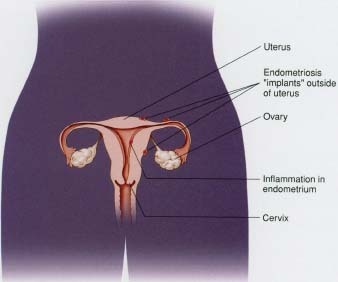Endometriosis
Endometriosis (en-do-me-tree-0-sis) is a chronic condition in which pieces of the lining of the uterus (YOO-ter-us) become embedded in tissues outside the uterus.
KEYWORD
for searching the Internet and other reference sources
Gynecology
What Is Endometriosis?
Endometriosis is a condition in which endometrial tissue grows outside the uterus. The endometrium (en-do-ME-tree-um) is the lining of the uterus (womb), which is the muscular organ in which a fetus develops during pregnancy. During the monthly menstrual cycle, chemicals called hormones * cause the endometrium to grow thick in preparation for pregnancy. If the egg is not fertilized, the endometrium is shed as blood and tissue in the monthly menstrual period.
* hormones are chemicals that are produced by different glands in the body. Hormones are like the body's ambassadors: they are created in one place but are sent through the body to have specific regulatory effects in different places.
In a woman with endometriosis, fragments of endometrial tissue are implanted outside the uterus. The origin of endometriosis is not known for sure, but scientists speculate that parts of the endometrium may not leave the body during menstruation. Instead, these stray fragments find their way into other parts of the pelvic cavity. These stray pieces of tissue can attach to other organs, stick organs together, or form scar tissue.

What Are the Symptoms and Effects of Endometriosis?
Endometrial implants outside the uterus respond to hormones in the same way as endometrial tissue inside the uterus: they grow, break down, and bleed. The blood released by implants is irritating to the internal tissues and causes pain. Although some women with endometriosis do not have any symptoms, for others the symptoms of endometriosis include heavy bleeding during menstruation, abdominal and lower back pain, tenderness and pain in the pelvic area, diarrhea, constipation, and bleeding from the rectum.
Endometriosis affects women mostly between the ages of 25 and 40. It is a major cause of infertility (the inability to conceive a child) in women, because endometrial implants may block the fallopian tubes or may prevent the eggs from leaving the ovaries, making it impossible for a women to get pregnant. About 30 to 40 percent of women who have endometriosis have difficulty becoming pregnant, and women with endometriosis represent about 10 to 15 percent of women who are infertile.
How Is Endometriosis Diagnosed?
A doctor may suspect that a woman has endometriosis based on her history of symptoms. To diagnose endometriosis, the doctor uses a procedure called laparoscopy (lap-a-ROS-ko-pee), in which a viewing instrument (a laparoscope) is inserted into the abdomen or pelvic cavity through a small incision. This allows the doctor to examine the abdominal or pelvic cavity for pieces of endometrium that may have become implanted on surfaces where they usually are not found.
How Is Endometriosis Treated?
Endometriosis is treatable, but there is no cure for the condition. In mild cases, treatment may not be necessary. When treatment does become necessary, it may be complicated. The age of the woman, her general health, how severe her condition is, and whether she wants to have children all must be considered.
Hormone medications have been developed that can suppress the development of endometrial tissue or cause the fragments to wither away, which may take as long as six months. Other medications may be prescribed to relieve pain. Sometimes surgery is involved to remove some of the abnormal tissue. Older women not planning to have more children may consider having a hysterectomy (his-ter-EK-to-mee) to solve the problem. This is surgery to remove the uterus and sometimes other reproductive organs.
Hormones and Endometriosis
The menstrual cycle is controlled by changing levels of hormones. Estrogen, progesterone, and prostaglandins regulate the buildup and the shedding of the endometrial lining of the uterus. Changes in these hormone levels, caused by pregnancy or by oral contraceptives, (birth control pills), can be helpful in relieving symptoms of endometriosis.
Most women with endometriosis are able to have children, and many are free of symptoms when they are pregnant. During pregnancy, the hormone balance that usually causes the monthly menstrual cycle changes. Instead of causing the endometrium to grow and then break down, different hormones work to take care of a developing fetus. Therefore, the implants may be free of the hormonal effects that cause the symptoms of endometriosis.
Oral contraceptives (birth control pills) are mixtures of reproductive hormones that, when taken everyday, act to change the hormone balance in the body to prevent pregnancy. Side effects of oral contraceptives include less cramping and lighter menstrual periods. By altering the body's hormonal balance, they also can be effective in reducing the symptoms of endometriosis.
Resources
Book
Ballweg, Mary Lou. The Endometriosis Sourcebook. New York: Contemporary Books, 1995.
Organizations
The U.S. Food and Drug Administration posts a fact sheet called
On the Teen Scene: Endometriosis: Painful, but Treatable
at its website.
http://www.fda.gov/opacom/catalog/ots_endo.html
Endometriosis Association International Headquarters, 8585 North 76th
Place, Milwaukee, WI 53223-2600.
Telephone 800-992-3636
Comment about this article, ask questions, or add new information about this topic: